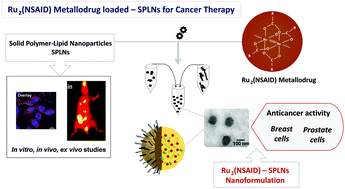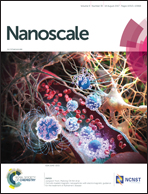Diruthenium(ii,iii) metallodrugs of ibuprofen and naproxen encapsulated in intravenously injectable polymer–lipid nanoparticles exhibit enhanced activity against breast and prostate cancer cells†
Abstract
A unique class of diruthenium(II,III) metallodrugs containing non-steroidal anti-inflammatory drug (NSAID), Ru2(NSAID), have been reported to show anticancer activity in glioma models in vitro and in vivo. This work reports the encapsulation of the lead metallodrug of ibuprofen (HIbp), [Ru2(Ibp)4Cl] or RuIbp, and also of the new analogue of naproxen (HNpx), [Ru2(Npx)4Cl] or RuNpx, in novel intravenously (i.v.) injectable solid polymer–lipid nanoparticles (SPLNs). A rationally selected composition of lipids/polymers rendered nearly spherical Ru2(NSAID)-SPLNs with a mean size of 120 nm and zeta potential of about −20 mV. The Ru2(NSAID)-SPLNs are characterized by spectroscopic techniques and the composition in terms of ruthenium-drug species is analyzed by mass spectrometry. The metallodrug-loaded nanoparticles showed high drug loading (17–18%) with ∼100% drug loading efficiency, and good colloidal stability in serum at body temperature. Fluorescence-labeled SPLNs were taken up by the cancer cells in a time- and energy-dependent manner as analyzed by confocal microscopy and fluorescence spectrometry. The Ru2(NSAID)-SPLNs showed enhanced cytotoxicity (IC50 at 60–100 μmol L−1 ) in relation to the corresponding Ru2(NSAID) metallodrugs in breast (EMT6 and MDA-MB-231) and prostate (DU145) cancer cells in vitro. The cell viability of both metallodrug nanoformulations is also compared with those of the parent NSAIDs, HIbp and HNpx, and their corresponding NSAID-SPLNs. In vivo and ex vivo fluorescence imaging revealed good biodistribution and high tumor accumulation of fluorescence-labeled SPLNs following i.v. injection in an orthotopic breast tumor model. The enhanced anticancer activity of the metallodrug-loaded SPLNs in these cell lines can be associated with the advantages of the nanoformulations, assigned mainly to the stability of the colloidal nanoparticles suitable for i.v. injection and enhanced cellular uptake. The findings of this work encourage future in vivo efficacy studies to further exploit the potential of the novel Ru2(NSAID)-SPLN nanoformulations for clinical application.

- This article is part of the themed collection: Materials and Nano Research in Brazil


 Please wait while we load your content...
Please wait while we load your content...